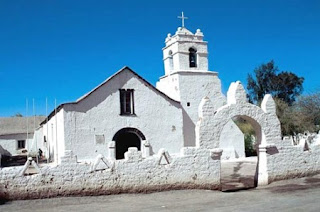 One of San Pedro de Atacama most popular tour is the Moon Valley tour. It takes you to an amazing journey through the Salt Mountain Range, just beside San Pedro de Atacama; here you can observe a geological phenomenon that give shape to enormous mineral sculptures formed by wind and rain. You will visit a nice viewpoint where you can see San Pedro de Atacama, the Death Valley and the Moon Valley.
One of San Pedro de Atacama most popular tour is the Moon Valley tour. It takes you to an amazing journey through the Salt Mountain Range, just beside San Pedro de Atacama; here you can observe a geological phenomenon that give shape to enormous mineral sculptures formed by wind and rain. You will visit a nice viewpoint where you can see San Pedro de Atacama, the Death Valley and the Moon Valley. DEATH VALLEY
On this range, located 2 kilometers to the west of San Pedro de Atacama, you can observe a geological phenomenon of enormous mineral sculptures formed by the wind and rain. San Pedro de Atacama geological origin comes from an emerged lake, where the old horizontal layers of sediment and rock, dating at around 23 million years, were pushed and folded by the movements of the Earth’s crust, lifting the Andes Mountain Range, and leaving some layers in a vertical position. The Salt Mountain Range has been shaped throughout time by the rain and the wind, giving rise to enormous shapes and mineral brilliance made up of salt hills, gypsum and clay, spectacular natural sculptures, of various colors as a result of the minerals that form part of this natural attraction in San Pedro de Atacama.
MOON VALLEY
This site, located 19 kilometers from San Pedro de Atacama, was declared a Sanctuary of Nature. Its landscape resembles the surface of the moon with small but sharp crested hills formed by the wind, such as the three Maria’s and the amphitheater.
This valley, located on the Salt Mountain Range, heading west from San Pedro de Atacama and bordering the Salar de Atacama, is beautiful for its resemblance to the surface of the moon. This geological site situated at 2,550 meters above sea level, the same than San Pedro de Atacama, formed 22 million years ago when the folding of the upper strata of the earth’s crust began to take place. In San Pedro de Atacama the volcanic activity of the time deposited bits of rock and ash on these folds. Today it is made up of sedimentary rocks with fragments of salt, gypsum, chlorate, borate, and clay. The wind from San Pedro de Atacama and the atmospheric conditions have carved sculpture shapes with sharp crests, hilltops and waves that transform the landscape of San Pedro de Atacama into the most extraordinary in our country. The absence of animal and vegetable life as well as the lack of humidity makes this the most inhospitable corner on Earth.
We invite you to visit San Pedro de Atacama, and enjoy all the beautiful tourist attractions San Pedro de Atacama have to offer.








